Today Huawei announced a new 64-Core Arm Server CPU. The Huawei Kunpeng 920 is being billed as the fastest Arm CPU to date. One thing is for sure, there is going to be interest in this CPU not just for the 64 custom Arm cores, but also the I/O that the chip has onboard. We thought we would take a moment to show what Huawei is building, and why it is important.
Huawei Kunpeng 920 64-Core Arm Server CPU
Huawei has a design team that has been producing CPUs for years. We are going to get into the business reason for this in a bit, but what the company is doing seems far from gluing Arm cores together. Instead, the company is producing an integrated chip with high-speed I/O. Further, it is the first dual socket Arm 7nm server chip that has been publicly announced. It is also the first chip with DDR4-2933 support, a spec we expect companies like Intel and AMD to match with their 2019 parts.
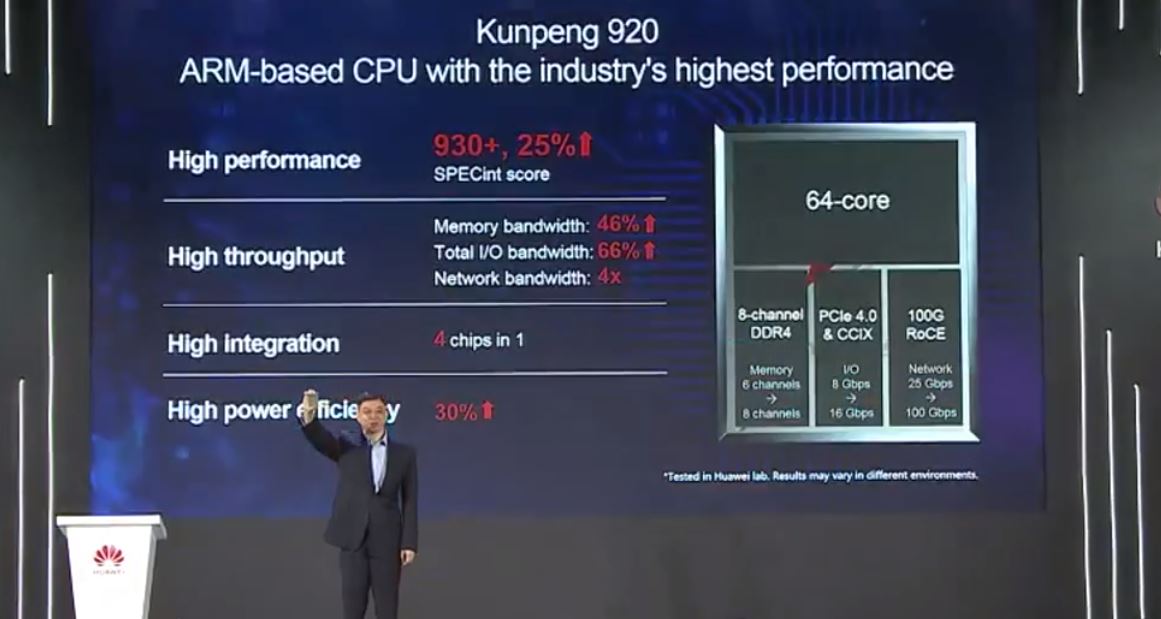
Beyond the CPU cores and 8 channel DDR4-2933 memory controller, the company is also introducing PCIe Gen4 and CCIX support. We know that AMD EPYC Rome will support PCIe Gen4 this year (likely with CCIX), and Intel Cascade Lake will not. Like we saw Cavium do with the original ThunderX, Huawei is also integrating networking with a 100GbE RoCE NIC in the Kunpeng 920.
Huawei believes the high core count and solid clock speeds of 2.6GHz will give it enough performance to be ahead of many of the competitive offerings out there. We will take a second to note that with both AMD and Intel pushing close to 4GHz, the 2.6GHz Arm cores are likely not going to match single thread performance. All of the numbers we have seen from Huawei are using multiple threads and the 25% faster claim is using the depreciated SPEC CPU2006 integer test, not the current generation SPEC CPU2017 that we used in our Cavium/ Marvell ThunderX2 launch piece.

Overall, this is an interesting Arm server offering, and we expect more high core count Arm CPUs to come out in the coming year(s). AMD will have a 64 core part this year and Intel will have a 48 core, higher clock speed part with Cascade Lake-AP.
Business Side of the Kunpeng 920
Beyond the chip itself, there are a number of commercial questions raised by the Huawei Kunpeng 920. First is, where will they get used? A new Huawei TaiShan server line will utilize the chips. There are three servers that will include the chips. One is the Huawei TaiShan 2280 which is a traditional 2U dual socket form factor. The TaiShan 5280/ 5290 is a storage server platform in 4U 40-bay and 72-bay configurations. Finally, the Huawei TaiShan X6000 is a 2U 4-node server.
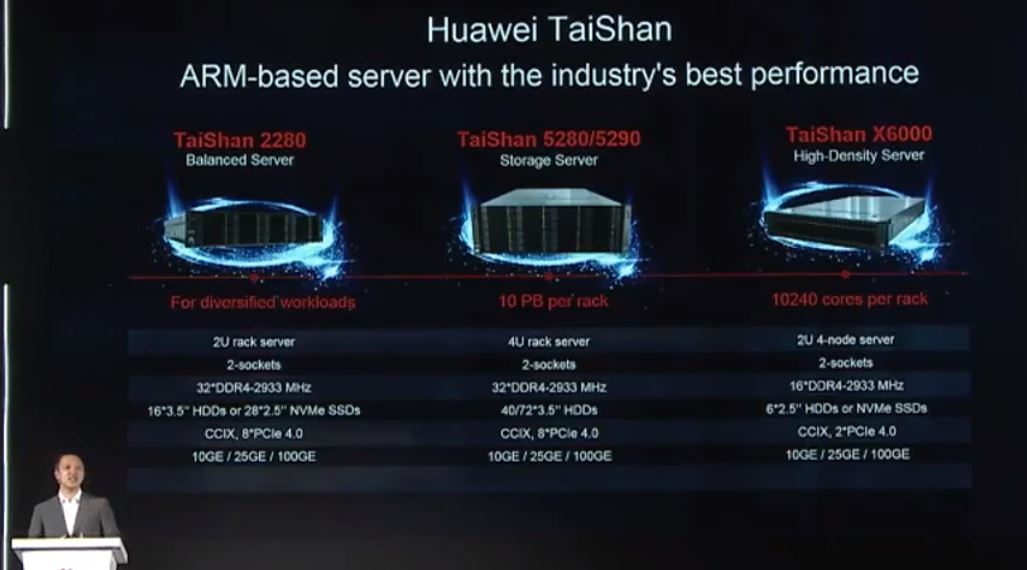
Although the spec was not listed in what we saw, the 32x DDR4-2933 maximum spec seems to indicate that the Huawei Kunpeng 920 is a two DIMM per channel design.
Beyond the traditional server form factors, the company is announcing their intent to offer the Huawei Cloud ARM service which will have elastic compute and bare metal provisioning for the Kunpeng 920 based servers. Companies can use this for things like Arm phone services. Huawei says that the cloud service will be up to 3x the performance of the AWS EC2 A1 Graviton based instances. We putting the AWS Graviton and its Arm CPU performance in context and found that AWS’s offering was not up to par with modern single socket performance.
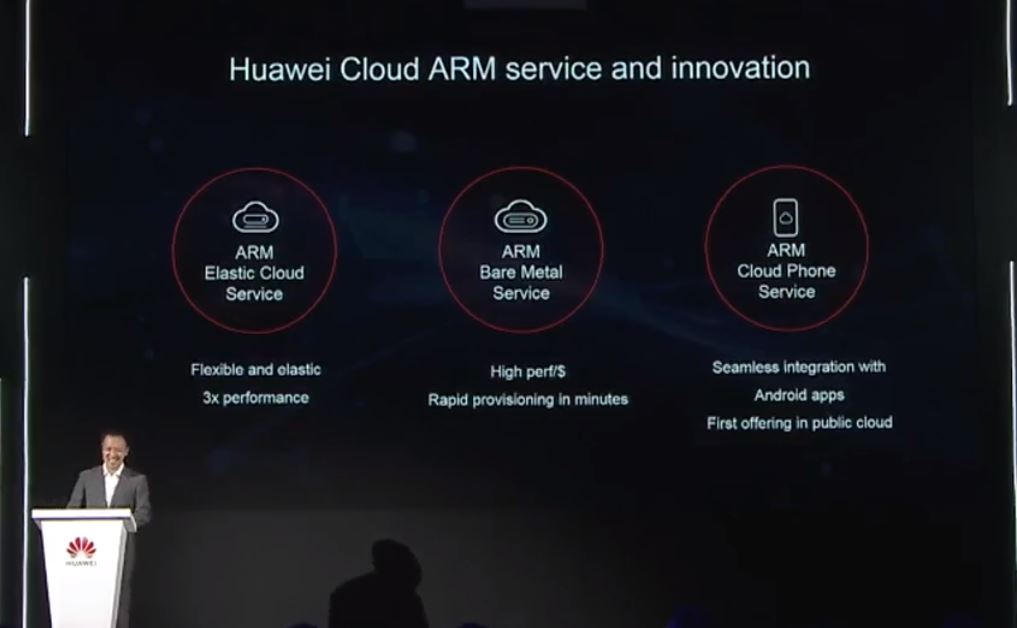
A fascinating aspect to the presentation was the ecosystem slide, specifically the hardware swim lane.
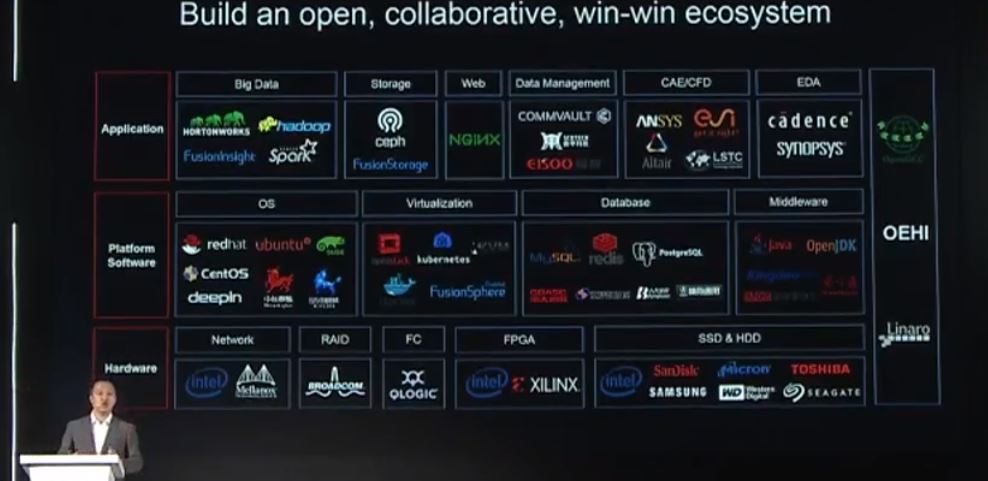
One can see that Intel is in three of the five Huawei Arm hardware partner boxes. When we discussed how Intel is focused beyond just supplying CPUs to achieve higher TAM, for example in Intel One API to Rule Them All Is Much Needed, this is a great example. Even if the sever is using an Arm CPU, Intel has a number of other vectors to play in.
Final Words
In 2019, we are going to hear a lot more about the Arm Neoverse. Huawei is not aiming to be a merchant of silicon for others to use such as with the ThunderX2 and Ampere eMAG. Instead, Huawei is using the chips, like AWS is, to offer its own products and services. That is important for two reasons. First, it is a great bargaining tool for negotiations with Intel. Second, it is also setting up a dichotomy in the Arm space where there will be two types of Arm CPUs people use. There will be vendor specific CPUs and on the other end of the spectrum merchant CPUs. This is much like in the smartphone space where there are custom Apple SoC’s and merchant Qualcomm SoCs. Arm vendors are working on building a base infrastructure for compatibility purposes.
We look forward to companies pushing the CPU envelope with designs like the Huawei Kunpeng 920. While 2019 has just started, it is going to be one of the most interesting years in server CPUs in over a decade.

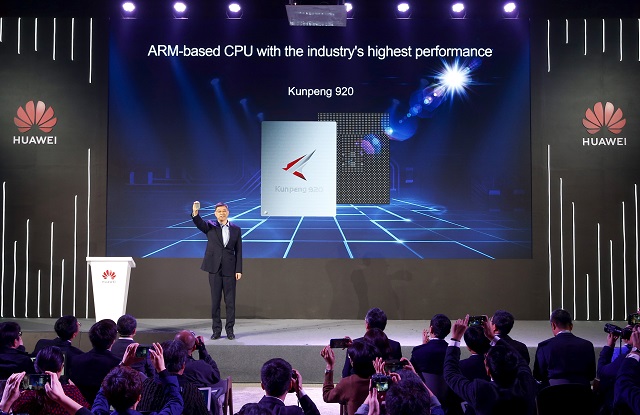


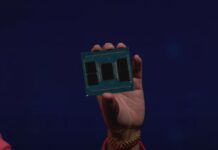
With five-eyes governments stripping Huawei gear out of sensitive installations (5G networks), supply chain risks have to be a factor for US and EU based potential customers?
Don’t underestimate the evil of Chinese government. You betcha they put some bonus circuits in there, or at least will use the money raised by the sales to do this or other nasty stuff in future. My local Chinese restaraunt has a TV always pointed to one of their channels. Every other story on the news is a piece of military propaganda, soviet-style, and I know the smell.
At least till today, no leaks where found in Chinees hardware. In Cisco(US) hardware at least 9 leaks where found.
Every country has it’s own propaganda. USA probably is the most aggressive one. How is this related to the “evil” of the government?
Huawei is using its new server chip on their own Cloud service because otherwise they would not have a place for it.
They know that selling server chips takes much more than manufacturing a good processor. It takes a whole ecosystem, it takes huge efforts in platform optimization (compilers, OSs, drivers, etc) and you need to deal with fears of using Chinese hardware.
By running their own cloud, they can put millions of their chips in production soon and learn and evolve from that. Further down the road they will have a much better product to actually then sell to others.
And they will have plenty of money to do so because I am sure Huawei is a big part of Made in China 2025 program.
To Marcelo B:
“t takes a whole ecosystem, it takes huge efforts in platform optimization (compilers, OSs, drivers, etc) ”
It’s already there, buit it seems you don’t know. AArch64 is already supported by Redhat, CentOS, Suse, and others. There are compilers, OSs, drivers, etc. I work in the Telco industry, rented some ThunderX servers on the Cliud, running CentOS 7.4, recompiled some of our aplications (mostlry C++) , and they worked perfectly.
Amazon is already offering ARM servers in its cloud, though with their own ARM Graviton processor, slow compared with Kunpeng 920 or Cavium(Marvell) ThunderX2 and Ampere eMAG processors.